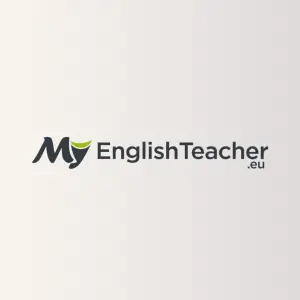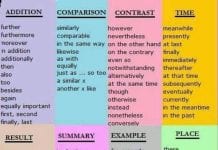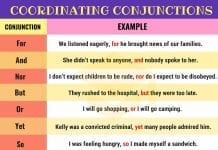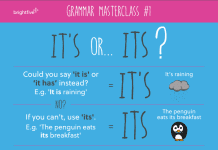Sentence patterns are something that all English speakers struggle with, here are some patterns to help you form sentences with ease.
Let’s first take a look at the patterns, and then we’ll make some sentences.
The Patterns/ Word Patterns Definition
1. Pattern
The verb to be as the main verb in the sentence.
- is
- are
- was
- were
- has been/have been
- had been
2. Pattern
Linking verb + a noun or Linking verb + an adjective (in this case the adjective functions as the subject of the sentence)
Examples:
- smell
- taste
- look
- feel
- seem
- become
- appear
- grow
3. Pattern
An action verb is used as the main verb in the sentence. The action verb can be transitive, where is takes an object in a direction, or non- transitive, where it does not takes an object in a direction.
- see
- jump
- embrace
- write
- imagine
- buy
- plummet
- think
Skype English Lesson with a native AMERICAN or BRITISH teacher ››
Basic Parts of Speech
We’re going to break down some example sentences that use these three patterns. Here are some basic parts of speech that you will need to know to follow along.
Parts of a sentence that matter.
The subject of the sentence
This is who or what the sentence is about. You can find it by simply asking the question who did something or what are we talking about.
Verb to be
This verb uses the forms is, am, and are in the present tense, as well as was and were in the past tense, and will be in the future tense. Been and being are it’s past participle forms.
Linking Verbs
Linking verbs link the subject of the sentence to the action of the sentence. For example My cat is fat. My cat is the subject of the sentence and the action (or what I’m saying about him) is that he’s fat. Those two words are linked together by the word is.
Another example is My cat appears fat. My cat is still the subject, and I’m still saying he’s fat. I link those two words together with the word appears.
Here’s an extra hint to tell if a verb is a linking verb. Any linking verb can be replaced with a form of the verb to be.
A linking verb is any form of the verb to be, plus verbs that refer to the five senses. Here are some linking verbs that are often used, taste, become, appear, grow, feel, look, stay, turn, remain, seem,smell, and sound.
Action verb
These are things that you do. If something is an action verb you can physically do it; walk, run, jump, give, hold. You can also add ing to action verbs.
Time or place
This just tells when or where something happened. For example this includes the words, here, there, this morning, tomorrow, at home, at school, and last year.
Adjective
This describes a noun. For example blue car, pink pig, pretty girl. These are all describing words.
If this feels like a lot of grammar, don’t be overwhelmed. The most important things to remember are…. (please notice the abbreviations that we will use when building sentences)
Subject=S– this is who or what the sentence is about.
The verb to be = Vbe (this is probably the first verb you learned)
Linking Verb= LV – these include the verb to be and the five sense (taste, smell, look, feel, touch)
Action Verbs=AV– these are something you can physically do.
Time or Place=TP– this is when and where something happens.
Adjectives= A– these are words that describe people, objects, and places (nouns)
Noun= N– is a person, place or thing.
Forming Sentences
Ok, let’s make some sentences!
- Let’s start simple.
Subject + the Verb to be+ an action verb
- I am walking.
S+ Vbe+ AV
- She was running.
S+ Vbe+ AV
- We will be playing.
S+ Vbe+ AV
Notice all of the action verbs end in “ing”, that is always the case with the verb to be.
Now let’s change things up a bit. Instead of using a basic pronoun as the subject, let’s use another noun.
- The dog is walking.
S+ Vbe+ AV
- Mary was running.
S+ Vbe+ AV
- The teams will be playing.
S+ Vbe+ AV
Now let’s add a place.
Subject + the Verb to be+ an action verb+ a place
- The dog is walking in the park.
S+ Vbe+ AV+ TP
- Mary was running away.
S+ Vbe+ AV+ TP
- The teams will be playing here.
S+ Vbe+ AV+ TP
Skype English Lesson with a native AMERICAN or BRITISH teacher ››
Now let’s add time. Time phrases usually go at the beginning or the end of a sentence. In a compound sentence they can go at the beginning or end of either clause of the sentence.
- The dog is walking in the park right now.
S+ Vbe+ AV+ TP+ TP
- Yesterday, Mary was running away.
TP+ S+ Vbe+ AV+ TP
- The teams will be playing here tomorrow.
S+ Vbe+ AV+ TP+ TP
Now let’s add an adjective to our sentences. These will go before the noun, which could be the subject.
- The lazy dog is walking in the park right now.
A+ S+ Vbe+ AV+ TP+ TP
- The dog is walking in the biggest park right now.
S+ Vbe+ AV+ A+ TP+ TP
- Yesterday Mary was running away quickly.
S+ Vbe+ AV+ TP+ TP+ A
- The best teams will be playing here tomorrow.
A+ S+ Vbe+ AV+ TP+ TP
Here are some other ways the you can easily organize sentence.
- The coffee cup is over there.
S + Vbe +TP
- The chairs will be here tomorrow
S + Vbe +TP+ TP
- The flowers couldn’t be more beautiful.
S+ Vbe+ A
- The kids are at the game.
S+ Vbe + TP+ Noun
- The computer looks broken.
S+ LV+ A
- The kitten became a cat.
S+ LV= Noun
- She runs downtown.
S+ AV + Noun
- Jack walked home quickly.
S+ AV+ Noun + A
- Sam showed he is a loyal friend.
S+ AV+ Noun+Vbe+ A+ N

























